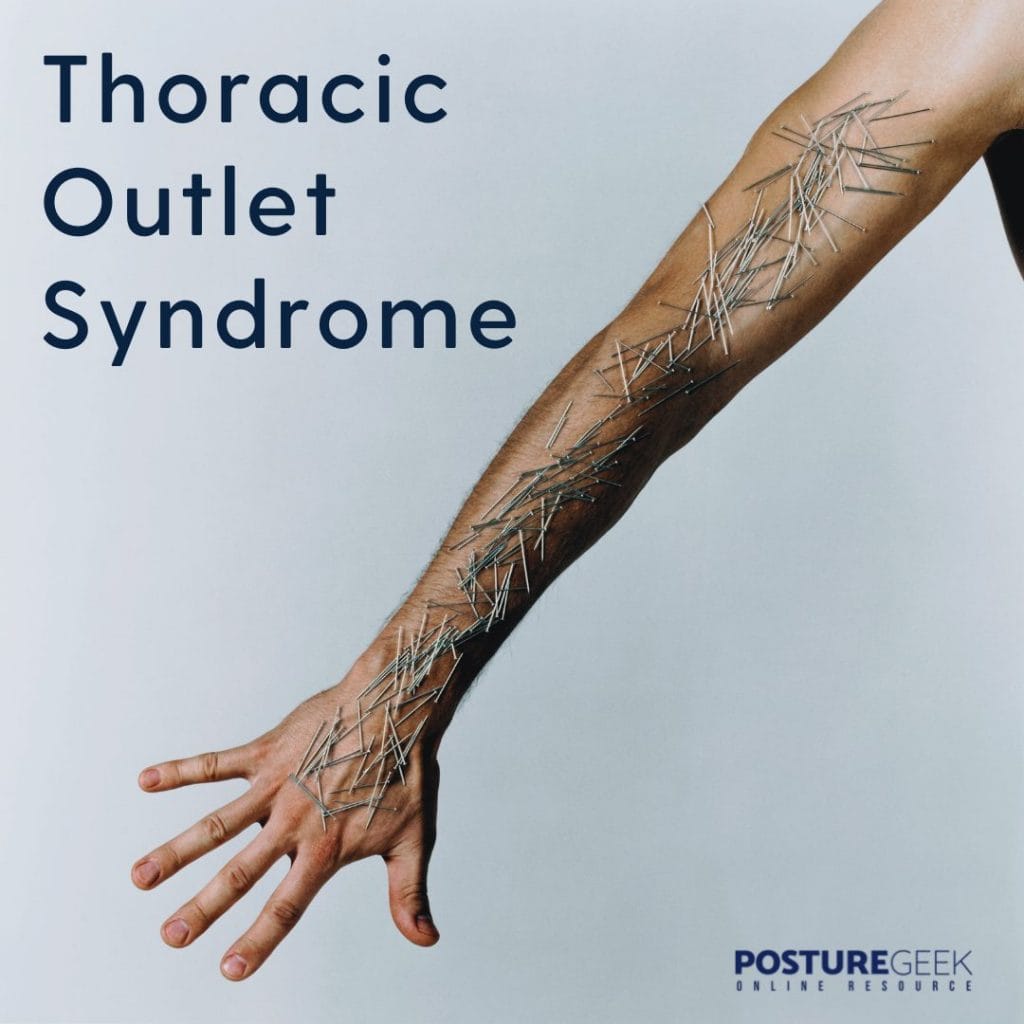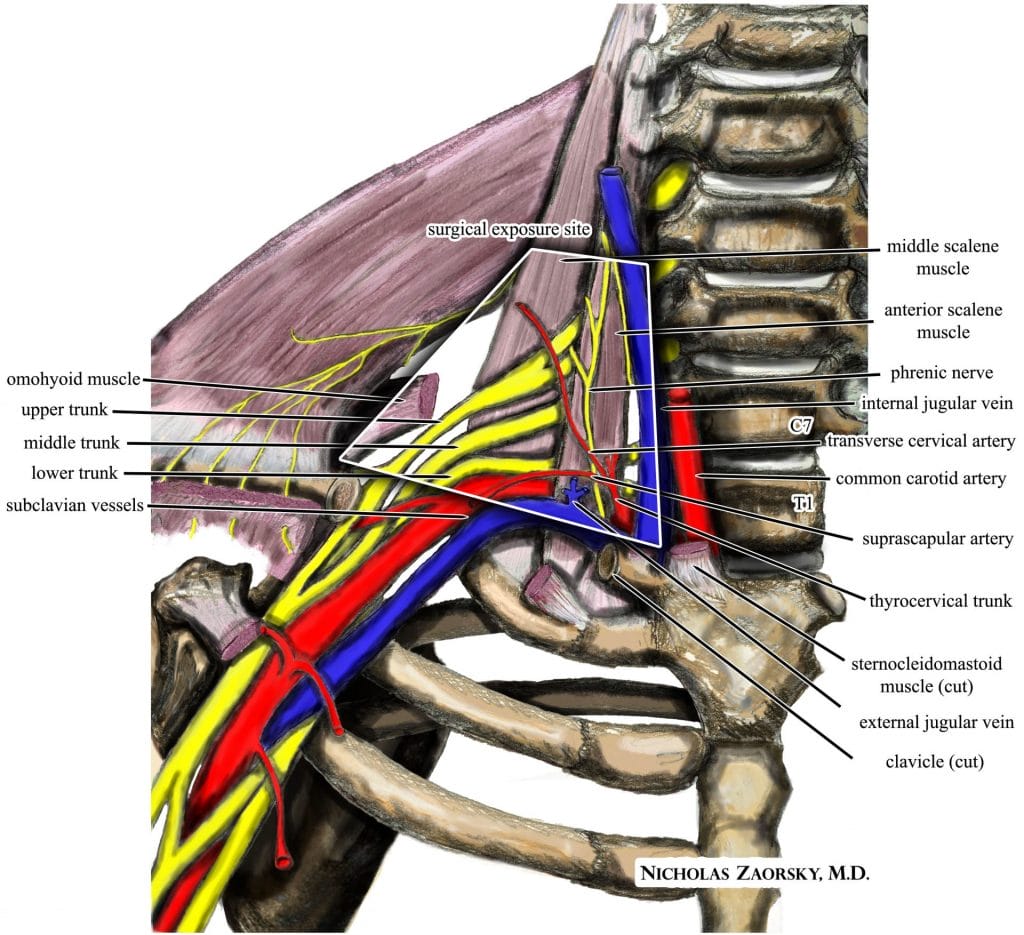Thoracic Outlet Syndrome: What is it? What problems may arise from it?

Thoracic Outlet Syndrome is a condition that can arise from various problems within the Thoracic Outlet. The Thoracic Outlet is located between the collarbone and first rib, and it contains blood vessels and nerves. If these structures are compressed, it can lead to pain, tingling, numbness, and weakness in the arm and hand.
In this blog post, we will discuss what it is, what problems may arise from it, how poor posture can impact the Thoracic Outlet, and who may assist you in treating it.
Thoracic Outlet Syndrome is a condition that can arise from various problems within the Thoracic Outlet.
PostureGeek.com Tweet
What is the Thoracic Outlet?

The Thoracic Outlet is located between the collarbone and first rib, and it contains blood vessels and nerves. The Thoracic Outlet can be further divided into three parts:
Supraclavicular
The Supraclavicular Portion is located above the clavicle, and it contains the subclavian artery and vein.
Infraclavicular
The Infraclavicular Portion is located below the clavicle, and it contains the axillary artery and vein.
Thoracic
The Thoracic Portion is located in the middle of the chest and contains the brachial plexus.
What is Thoracic Outlet Syndrome?
Thoracic Outlet Syndrome occurs when structures in the Thoracic Outlet are compressed. It can be due to:
- Anatomical abnormalities,
- Trauma,
- Repetitive use of arms and hands, or
- Poor posture.
The most common type of Thoracic Outlet Syndrome is due to poor posture, which can be caused by slouching. It is most common in women, and it occurs more often in people who are 20-40 years old.
What are the types of thoracic outlet?
There are three types of Thoracic Outlet Syndrome:
- Neurogenic, which is caused by compression of the nerves within the Thoracic Outlet
- Vascular, which is caused by compression of the blood vessels within the Thoracic Outlet
- Combined Neurogenic and Vascular, which is caused by compression of both the nerves and blood vessels within the Thoracic Outlet
What problems may arise from Thoracic Outlet Syndrome?

Thoracic Outlet Syndrome can cause pain, tingling, numbness, and weakness in the arm and hand. It can also affect other structures within the Thoracic Outlet, such as blood vessels or nerves.
It may be due to an anatomical abnormality such as a cervical rib or clavicle fracture; if due to trauma then it may be caused by an injury.
Thoracic Outlet Syndrome can also affect people who use their arms and hands repetitively, such as keyboard users or athletes.
What is a cervical rib?
A cervical rib is an extra bone that occurs near the base of the neck. A cervical rib can cause compression within the Thoracic Outlet, which can lead to Thoracic Outlet Syndrome.
What is nerve compression?
Nerve compression occurs when a nerve is compressed. This can lead to pain, tingling, numbness, and weakness.
How do I know if Thoracic Outlet Syndrome is affecting me?
As already noted this syndrome can cause pain, tingling, numbness, and weakness in your arm and hand. It may also affect your posture and movement. If you are experiencing any of these symptoms, it is important to see a physiotherapist or other recognized health care provider for assessment.
How does poor posture impact?

Poor posture can cause compression of the structures within the Thoracic Outlet. For example, your head and neck sink down when you slouch and round your shoulders. This can be characterized as Forward Head Posture or Upper Cross Syndrome. These patterns can lead to compression of the structures in the Thoracic Outlet. This is especially true if you have an anatomical abnormality, such as a cervical rib or clavicle fracture.
How is thoracic outlet syndrome diagnosed?
Thoracic Outlet Syndrome can be diagnosed through a physical examination and imaging studies such as an MRI or CT scan. A physical examination will include evaluating the patient’s symptoms and an assessment of the Thoracic Outlet. Imaging studies will help identify any anatomical abnormalities that may be causing compression of the structures in the Thoracic Outlet.
What treatment options are available?

Thoracic Outlet Syndrome is typically treated by physiotherapists, chiropractors, or a range of other health care providers. It can be treated with physical therapy exercises and manual therapies such as joint mobilizations or soft tissue release techniques. Your therapist or medical provider will be able to assist you with a treatment plan that is right for you.
Thoracic outlet syndrome may also require surgery if other treatments are not successful. Thoracic outlet surgery is a minimally invasive surgery that can be used to release the compression on the structures within the Thoracic Outlet.
If you are experiencing pain, tingling, numbness, and weakness in your arm and hand, it is important to see a recognized health care provider for assessment.
How can you prevent thoracic outlet syndrome?
There is no known way to prevent Thoracic Outlet Syndrome. However, you can take steps to improve your posture and reduce the risk of developing it.
PostureGeek.com Tweet
There is no known way to prevent Thoracic Outlet Syndrome. However, you can take steps to improve your posture and reduce the risk of developing it.
When you sit or stand, be sure to maintain a neutral spine position. This means keeping your head and neck in line with your spine and avoiding slouching or hunching over when sitting.
Thoracic Outlet Syndrome can affect people who use their arms and hands repetitively, such as keyboard users or athletes, so it’s important to be aware of your posture when working on a computer or playing sports.
Finally
Thoracic Outlet Syndrome is a condition that occurs when structures within the Thoracic Outlet are compressed. This can be due to anatomical abnormalities, trauma, repetitive arms and hands, or poor posture. A common type is due to poor posture, which can be caused by slouching.
Thoracic Outlet Syndrome can cause pain, tingling, numbness, and weakness in the arm and hand. It may also affect other structures within the Thoracic Outlet, such as blood vessels or nerves. If you feel affected by this syndrome, it is essential to seek medical attention.
PLEASE NOTE
PostureGeek.com does not provide medical advice. This information is for educational purposes only and is not intended to be a substitute for professional medical attention. The information provided should not replace the advice and expertise of an accredited health care provider. Any inquiry into your care and any potential impact on your health and wellbeing should be directed to your health care provider. All information is for educational purposes only and is not intended to be a substitute for professional medical care or treatment.
